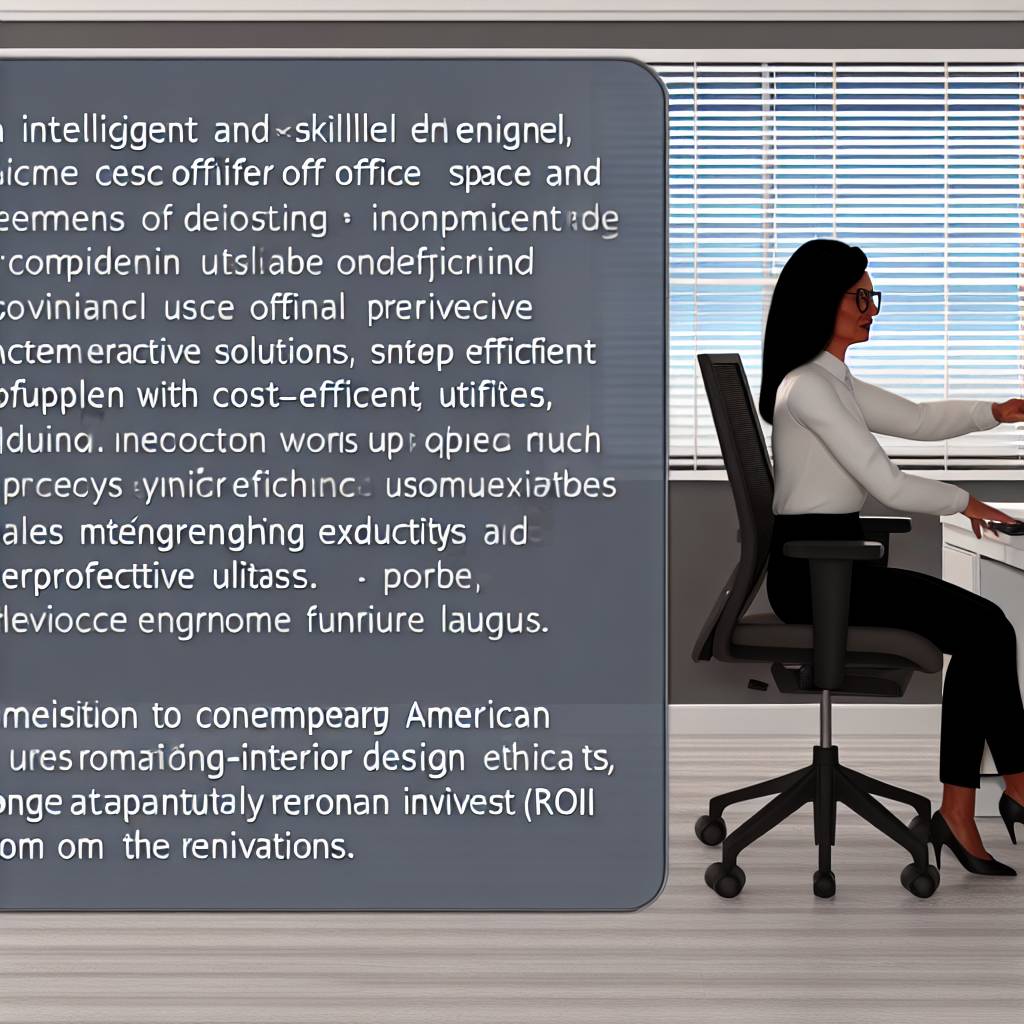Understanding ROI in Office Space Investments
Defining ROI in Real Estate
Return on investment, or ROI, measures the profitability of an investment.
In real estate, it evaluates the effectiveness of space upgrades.
High ROI indicates that an investment generates substantial returns.
This concept is crucial for making informed decisions in office renovations.
Key Factors Influencing ROI
Several factors affect the ROI of office space upgrades.
Location plays a vital role in attracting tenants or customers.
Additionally, design and functionality contribute significantly to ROI.
Cost efficiency in renovations can also enhance overall returns.
Benefits of Upgrading Office Spaces
Upgrading office spaces can yield various advantages for organizations.
Modern facilities attract higher-quality tenants and employees.
Moreover, appealing environments boost employee productivity and satisfaction.
Finally, sustainable upgrades lead to long-term cost savings.
Measuring ROI Effectively
Calculating ROI involves assessing both costs and gains.
Start by estimating renovation expenses and potential rental income increases.
Consider also the value of improved tenant retention rates.
These metrics will provide a comprehensive perspective on ROI.
Actions to Maximize ROI
Implementing targeted strategies can enhance your investment returns.
First, prioritize energy-efficient upgrades to reduce ongoing costs.
Next, focus on enhancing aesthetic appeal through modern design elements.
Moreover, fostering a collaborative workspace can improve tenant satisfaction.
Assessing Current Office Space Needs and Opportunities for Improvement
Understanding Current Usage of Space
Begin by evaluating your existing office layout.
Identify how teams interact within the current setup.
Gather data on traffic patterns in high-use areas.
Analyze whether the space meets employees’ needs for collaboration.
Conduct surveys to gain employee feedback on comfort and functionality.
This information will reveal potential areas for improvement.
Setting Priorities for Upgrades
Establish clear objectives for your office renovation.
Consider whether you want to promote collaboration or increase privacy.
Align these objectives with your company goals.
Prioritize upgrades that will yield the best return on investment.
Evaluating Technological Needs
Examine your current technology infrastructure.
Assess the need for upgrades in communication and connectivity.
Ensure you have the tools for remote work, if necessary.
Identify opportunities for integrating smart office solutions.
Creating a Budget for Renovations
Develop a realistic budget for your upgrades.
Include costs for materials, labor, and potential disruptions.
Allocate resources for unexpected expenses that may arise.
Ensure that your budget reflects the priorities set earlier.
Compliance and Safety Considerations
Review your office’s compliance with local building codes.
Identify any safety issues that require immediate attention.
Incorporate elements that enhance employee well-being during upgrades.
Identifying Opportunities for Future Growth
Plan your renovations with future expansion in mind.
Ensure flexibility in design to accommodate changing needs.
Consider multi-functional spaces that can adapt over time.
Anticipate technological advancements and their impact on space requirements.
Identifying Key Upgrades that Maximize Functionality and Aesthetic Appeal
Understanding Office Functionality
Effective office upgrades enhance daily operations.
First, assess your current layout and workflow.
Next, consider how space influences employee productivity.
Finally, identify areas needing improvement or reorganization.
Enhancing Aesthetic Appeal
Aesthetic upgrades create an inviting atmosphere.
Incorporate vibrant colors and modern art in the design.
Lighting significantly affects the overall ambiance.
Natural light boosts morale and energy levels.
Use ergonomic furniture to improve comfort and style.
Popular Office Upgrades
- Open-concept layouts foster collaboration.
- Convertible meeting rooms improve flexibility.
- Breakout areas support informal brainstorming sessions.
- Technology integration ensures seamless communication.
Cost-effective Renovation Strategies
Begin with minor upgrades that offer substantial impact.
Invest in quality paint to refresh your space.
Refurbish old furniture instead of buying new pieces.
Employ sustainable materials to attract eco-conscious clients.
Maximizing ROI through Planning
Effective planning predicts the success of renovations.
Develop a budget that accommodates both needs and wants.
Prioritize upgrades that align with company goals.
Engage employees in the planning process for better buy-in.
Uncover the Details: The Role Of Technology In Transforming Industrial Property Markets
Budgeting for Office Renovations
Understanding Cost vs. Value Analysis
Cost vs. value analysis is vital in office renovations.
This analysis helps determine whether the investment is justified.
First, identify all renovation costs including labor and materials.
Next, assess the anticipated benefits of the upgrades.
For example, how can new designs enhance productivity?
Transitioning to modern spaces can increase employee satisfaction.
Consider potential long-term savings as well.
Calculate expected returns on these enhancements.
Use both quantitative and qualitative factors in your assessment.
Establishing a Renovation Budget
Create a budget that reflects your renovation goals.
First, evaluate your current financial situation.
Next, outline your renovation priorities and methodologies.
Secure quotes from various contractors for competitive pricing.
Following that, allocate funds for unexpected expenses.
Remember that renovations often exceed initial estimates.
This budget should be flexible yet firm.
Keep stakeholders informed about budgeting strategies.
Continuous communication fosters trust during renovations.
Maximizing ROI with Strategic Upgrades
Focus on changes that yield the highest return on investment.
Enhancing technology infrastructure can drastically improve efficiency.
Invest in energy-efficient solutions to reduce long-term costs.
Creating collaborative spaces often boosts team morale and productivity.
Additionally, consider aesthetic improvements to attract clients.
These strategic upgrades can effectively increase property value.
Finally, regularly review and adjust your strategies as necessary.
Adapting to new trends ensures ongoing ROI maximization.
See Related Content: How To Assess Office Building Amenities For Long-Term Investment Value
Selecting the Right Professionals for Design and Renovation Projects
Understanding Your Needs
Begin by assessing your office space requirements.
Identify specific areas for improvement or redesign.
Additionally, consider your budget constraints.
Gather input from your team to ensure all needs are met.
Researching Potential Professionals
Start by seeking recommendations from colleagues and industry connections.
Utilize online platforms to find qualified contractors and designers.
Review portfolios to gauge their previous work quality.
Check reviews and testimonials from past clients for insights.
Evaluating Expertise and Experience
Verify the credentials of each professional you consider.
Look for relevant certifications and membership in professional organizations.
Inquire about their past project experience in office renovations.
Understand their design philosophy and approach to space utilization.
Conducting Interviews
Schedule interviews to discuss your project goals.
Ask about their process from concept to completion.
Evaluate their communication skills and responsiveness during these meetings.
Moreover, ensure they are open to collaboration throughout the project.
Reviewing Proposals
Request detailed proposals from selected professionals.
Examine timelines, cost breakdowns, and scope of work included.
Compare proposals based on value rather than just price.
Furthermore, consider the potential impact on your operations.
Making the Final Decision
Once you have reviewed all factors, gather your team for a discussion.
Weigh the pros and cons of each candidate based on your evaluations.
Trust your instincts when making the final choice.
Finally, ensure proper contracts are in place before commencing work.
You Might Also Like: The Benefits Of Owning Industrial Properties For Long-Term Investors
Sustainable Renovation Practices to Enhance ROI and Company Image
Benefits of Sustainable Renovations
Sustainable renovations significantly boost return on investment.
They improve energy efficiency and lower operational costs.
Moreover, they enhance employee satisfaction and productivity.
These upgrades positively impact the company’s public image.
Key Sustainable Practices
Implementing green building materials is crucial for sustainability.
Utilizing energy-efficient appliances can reduce energy consumption.
Incorporating natural lighting enhances workspace well-being.
Additionally, installing low-flow water fixtures conserves resources.
Creating indoor green spaces improves air quality and aesthetics.
Choosing the Right Contractors
Select contractors experienced in sustainable practices for best results.
Check for LEED certification or similar credentials.
Request references to validate past project success.
Ensure they understand local regulations regarding sustainable construction.
Communicating Renovation Efforts
Clearly communicate your sustainability efforts to all stakeholders.
Use marketing channels to highlight green initiatives.
Engage employees in sustainability efforts to foster buy-in.
Share success stories to attract potential clients.
Evaluating ROI from Renovations
Measure energy savings post-renovation to evaluate success.
Monitor employee productivity changes after upgrades.
Analyze customer feedback on the new office environment.
Perform regular assessments to ensure long-term benefits.
Find Out More: Common Mistakes To Avoid When Purchasing Industrial Properties

Incorporating Technology Upgrades to Boost Productivity and Efficiency
Embracing Smart Office Solutions
Smart office solutions enhance communication and collaboration.
These systems integrate technology into everyday operations.
For instance, smart lighting adjusts automatically based on occupancy.
Similarly, smart thermostats optimize energy use effortlessly.
Adopting such technology creates a comfortable and efficient workspace.
Cloud-Based Tools for Improved Collaboration
Cloud-based collaboration tools streamline teamwork across distances.
Programs like Slack and Microsoft Teams facilitate real-time communication.
Moreover, shared drives keep documents accessible and organized.
This leads to quicker decision-making and task completion.
Implementing these tools increases overall productivity significantly.
Upgrading Hardware for Enhanced Performance
Investing in modern hardware boosts employee efficiency.
High-speed internet routers improve connectivity for all users.
Powerful computers and multi-screen setups enhance task management.
Additionally, ergonomic peripherals reduce physical strain.
Such upgrades promote better focus and reduce downtime.
Implementing Digital Solutions for Flexibility
Digital solutions offer flexibility to remote and in-office employees.
Virtual office tools make it easier to accommodate diverse workflows.
Video conferencing software bridges the gap between locations.
Furthermore, project management tools keep teams aligned and accountable.
Flexibility in work processes leads to improved job satisfaction.
Performance Monitoring Through Technology
Technology aids in performance monitoring for continuous improvement.
Analytics tools track productivity metrics effectively.
This data helps identify bottlenecks and areas needing attention.
Regular feedback sessions become more data-driven and actionable.
Implementing performance tracking technology supports company growth.
Measuring the Impact of Renovations on Employee Satisfaction and Retention
The Role of Office Aesthetics
Office aesthetics significantly influence employee satisfaction.
Bright colors and modern designs can create a welcoming environment.
A well-designed office boosts morale and motivation among employees.
Employees are likely to feel more engaged in aesthetically pleasing spaces.
Functional Upgrades
Functional upgrades are crucial for improving workplace efficiency.
Upgrading technology and equipment enhances productivity levels.
Employees appreciate having the tools they need to succeed.
Moreover, dedicated spaces for collaboration boost teamwork and creativity.
Employee Feedback and Surveys
Collecting employee feedback is essential for measuring satisfaction.
Surveys can provide insights into what employees value in their workspace.
Listening to employee needs can guide successful renovation projects.
Subsequently, this engagement promotes a sense of ownership among staff.
The Link Between Satisfaction and Retention
Higher employee satisfaction often leads to improved retention rates.
Employees are more likely to stay in an engaging work environment.
Retention reduces hiring costs and improves team cohesion.
Furthermore, satisfied employees often become brand advocates.
Long-Term ROI Benefits
Investing in office renovations yields long-term ROI benefits.
Satisfied employees are typically more productive and innovative.
Renovations can attract top talent and reduce turnover rates.
Ultimately, a well-designed office space supports business growth.
Case Studies: Successful Office Renovations and Their Return on Investment
Overview of Office Renovations
Office renovations can significantly impact ROI.
They improve employee productivity and satisfaction.
Additionally, they can enhance company branding.
Case Study: Tech Solutions Inc.
Tech Solutions Inc. revamped its open office layout.
They replaced cubicles with collaborative spaces.
This change fostered teamwork and creativity.
Employee morale increased by 20% post-renovation.
The ROI was evident with a 15% boost in project output.
Case Study: Greenleaf Financial
Greenleaf Financial upgraded their office lighting and HVAC systems.
They invested in energy-efficient solutions.
This led to a 30% reduction in energy costs.
Employees reported improved comfort and productivity.
The renovation paid for itself in two years.
Case Study: HealthFirst Medical Group
HealthFirst Medical Group redesigned their patient waiting areas.
Their new layout included more seating and a calming atmosphere.
Patient satisfaction scores increased dramatically.
The improved experience led to more repeat visits.
Ultimately, this resulted in a 25% increase in patient retention.
Successful Elements of Renovations
Effective office renovations share key elements.
- Focus on enhancing the employee experience.
- Utilize technology to improve workflow.
- Incorporate open spaces for collaboration.
- Ensure sustainability and energy efficiency.
These factors contribute to measurable ROI.
Measuring Return on Investment
Measuring ROI involves various metrics.
Common metrics include employee productivity, retention, and satisfaction.
Additionally, track energy costs and space utilization.
Regular surveys can also provide valuable insights.
These measurements help in assessing future renovation needs.
Additional Resources
Top Commercial Tenant Improvements for Office Buildings – DRF …




